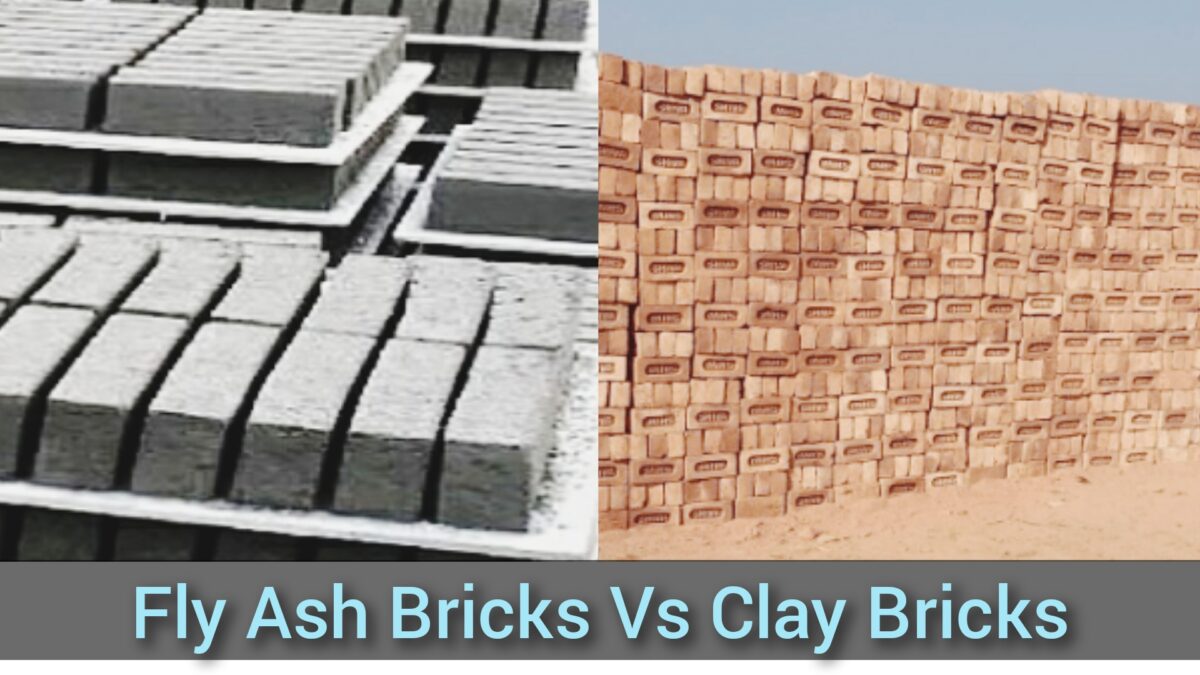In this blog article, I will explain all the differences between Fly Ash Bricks and Clay Bricks.

Let’s start!
Table of Contents
Difference Between Fly Ash Bricks And Clay Bricks
| Criteria | Fly Ash Bricks | Clay Bricks |
|---|---|---|
| Raw Material | Fly ash, cement, sand, water | Clay, water |
| Production Process | Produced using a hydraulic press | Produced by firing clay in a kiln |
| Strength | High compressive strength | Lower compressive strength |
| Porosity | Low porosity, less than 10% | High porosity, ranging from 20-25% |
| Density | Lower density, around 1,000-1,200 kg/m3 | Higher density, around 1,900-2,000 kg/m3 |
| Water Absorption | Low water absorption, less than 10% | High water absorption, ranging from 15-20% |
| Size | Uniform size and shape, with smooth edges | Non-uniform size and shape, with rough edges |
| Thermal Conductivity | Low thermal conductivity, making it an efficient insulator | High thermal conductivity, making it less efficient as an insulator |
| Sound Insulation | Good sound insulation properties | Poor sound insulation properties |
| Fire Resistance | High fire resistance, suitable for high-temperature applications | Lower fire resistance, not suitable for high-temperature applications |
| Efflorescence | Nil efflorescence, meaning no salt deposits on the surface | May occur efflorescence, resulting in salt deposits on the surface |
| Curing Time | Less curing time, as little as 7 days | More curing time, typically 21-28 days |
| Carbon Footprint | Lower carbon footprint, as fly ash is a waste material | Higher carbon footprint, as clay bricks require more energy to produce |
| Cost | Slightly more expensive than clay bricks | Less expensive than fly ash bricks |
| Availability of Raw Material | Fly ash is a byproduct of coal combustion and is abundant | Clay is a limited resource |
| Durability | Long-lasting and durable | Less durable and prone to weathering over time |
| Environmental Impact | Environmentally friendly, as it uses waste materials and reduces carbon emissions | May harm the environment due to the high energy consumption required during production |
| Maintenance | Low maintenance, as it is resistant to weathering and erosion | Higher maintenance, as clay bricks are more prone to erosion and weathering |
| Flexibility | Can be made in various shapes and sizes, suitable for customized projects | Limited flexibility, suitable only for standardized projects |
| Toxicity | Non-toxic, as it does not contain harmful chemicals | May contain harmful chemicals, such as lead and arsenic, if not produced under proper conditions |
| Aesthetic Appeal | Modern and sleek appearance, with a smooth surface finish | Traditional and rustic appearance, with a rough surface finish |
| Surface Finish | Smooth surface finish, suitable for painting and finishing | Rough surface finish, not suitable for painting and finishing |
| Thermal Stability | High thermal stability, suitable for extreme weather conditions | Lower thermal stability, not suitable for extreme weather conditions |
| Effort Required for Construction | Easy to handle and construct, reducing labor costs | Difficult to handle and construct, requiring more labor and time |
| Weight | Lighter in weight, reducing transportation costs | Heavier in weight, increasing transportation costs |
| Water Resistance | High water resistance, suitable for damp conditions | Lower water resistance, prone to water damage and erosion |
| Acid Resistance | High acid resistance, suitable for acidic soil conditions | Lower acid resistance, prone to corrosion in acidic soil conditions |
What Are Fly Ash Bricks?
These are factory-made bricks by mixing fly ash, cement, sand/stone dust, and water. Fly Ash Bricks are cheaper than clay bricks.

What Are Clay Bricks?
Clay bricks are made of clay, commonly formed into a rectangular shape and burnt in a kiln at an elevated temperature to harden. These bricks are most commonly and broadly used in construction works.
Read More:

Fly Ash Bricks Vs Clay Bricks: Key Points To Remember
- Fly ash bricks are made in molds thus are always of uniform shape. Clay bricks are irregular shapes and sizes as they as hand made.
- The color of fly ash brick is uniform and charming. But clay bricks are not uniform in color as the color of brick based on soil.
- Fly ash bricks have a smooth finish therefore plastering is not needed. Normal clay bricks always need plastering.
- Fly ash bricks are lighter in weight compare to clay bricks.
- The compressive strength of fly ash brick is around 100 kg/cm2 and the compressive strength of clay brick is approx 35 kg/cm2.
- Fly ash bricks can absorb more vibration compared to clay bricks.
- Fly ash bricks are less porous compare to clay bricks.
- Fly ash bricks are stronger and denser compare to typical clay bricks.
- Less mortar requirement in fly ash brick construction compares to clay brick construction.
- Fewer breakages and wastages compare to red clay bricks.
- The cost of fly ash bricks is approximately 30% lower compared to clay bricks.
- Fly ash bricks are more eco-friendly as they are made of waste materials that come from the combustion of coal in thermal power plants. But clay bricks are made of clay gathered from fertile land topsoil and chimney needed.
Conclusion
Thus from the above comparison, it is clear that fly ash bricks are better than clay bricks. You can utilize fly ash bricks in any construction without any doubt.
